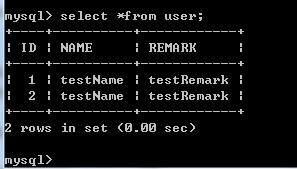本文目录
1 本文采用 hibernate4 整合 Spring3.1
2 把Spring获取datasource通过class="org.springframework.orm.hibernate3.annotation.AnnotationSessionFactoryBean"把datasource注入给hibernate的sessionfactory
3 注入后,配置sessionfactory的相关属性,例如实体类,properties
4 实体类上添加注解
5 编写测试类,测试通过
一 构建sessionFactory
1 datasource注入sessionfactory
a 把datasource注入到class="org.springframework.orm.hibernate3.LocalSessionFactoryBean"
注意: LocalSessionFactoryBean是hibernate3使用XML时使用的sessionfactory,所以不支持annotation----------------hibernate3的时候不推荐使用,hibernate4的时候自带annotation实现
b 把datasource注入到class="org.springframework.orm.hibernate3.annotation.AnnotationSessionFactoryBean" ----------------hibernate3的时候推荐使用
我使用的是hibernate4,编译的时候出了一个错误如下:
注意: java.lang.NoClassDefFoundError: Lorg/hibernate/cache/CacheProvider; (hibernate4整合spring3.1)
查了一下相关资料,原来发现hibernate4已经将hibernate3的一些功能改掉了,在hibernate4已经不使用CacheProvider了,所以做了以下修改,
原先:<bean id="sessionFactory"
class="org.springframework.orm.hibernate3.annotation.AnnotationSessionFactoryBean">
改成:<bean id="sessionFactory"
class="org.springframework.orm.hibernate4.LocalSessionFactoryBean">
问题解决,可以正常使用(本文是采用hibernate4整合spring3.1)
LocalSessionFactoryBean配置
<beans>
<bean id="myDataSource" class="org.apache.commons.dbcp.BasicDataSource" destroy-method="close">
<property name="driverClassName" value="org.hsqldb.jdbcDriver"/>
<property name="url" value="jdbc:hsqldb:hsql://localhost:9001"/>
<property name="username" value="sa"/>
<property name="password" value=""/>
</bean>
<bean id="mySessionFactory" class="org.springframework.orm.hibernate3.LocalSessionFactoryBean">
<property name="dataSource" ref="myDataSource"/>
<property name="mappingResources">
<list>
<value>product.hbm.xml</value>
</list>
</property>
<property name="hibernateProperties">
<value>
hibernate.dialect=org.hibernate.dialect.HSQLDialect
</value>
</property>
</bean>
</beans>
AnnotationSessionFactoryBean(推荐)
<bean id="mySessionFactory" class="org.springframework.orm.hibernate3.annotation.AnnotationSessionFactoryBean"> <!--这个支持annotation--> <property name="dataSource" ref="dataSource" /> <property name="mappingResources"> <list> <value>product.hbm.xml</value> </list> </property> <property name="hibernateProperties"> <value> hibernate.dialect=org.hibernate.dialect.HSQLDialect </value> </property> </bean>
2 注入hibernate需要的proptity的参数
<property name="hibernateProperties"> <value> hibernate.dialect=org.hibernate.dialect.MySQLDialect hibernate.show_sql=true </value> </property>
3 注入实体类
annotatedClasses是注入类
mappingResource是注入XML
<property name="annotatedClasses"> <list> <value>com.entity.User</value> </list> </property>
也可以使用自动扫描的方式注入实体类
<property name="packagesToScan"> <list> <value>com.entity</value> </list> </property>
同时在实体类上添上注解
package com.entity; import javax.persistence.Entity; import javax.persistence.Id; @Entity public class User { @Id private int id; private String name; private String remark; public String getName() { return name; } public void setName(String name) { this.name = name; } public String getRemark() { return remark; } public void setRemark(String remark) { this.remark = remark; } public int getId() { return id; } public void setId(int id) { this.id = id; } }
4 引入hibernate包
5 最后附上所有代码
beans.xml
<?xml version="1.0" encoding="UTF-8"?> <beans xmlns="http://www.springframework.org/schema/beans" xmlns:xsi="http://www.w3.org/2001/XMLSchema-instance" xmlns:aop="http://www.springframework.org/schema/aop" xmlns:context="http://www.springframework.org/schema/context" xsi:schemaLocation="http://www.springframework.org/schema/beans http://www.springframework.org/schema/beans/spring-beans.xsd http://www.springframework.org/schema/context http://www.springframework.org/schema/context/spring-context.xsd "> <context:component-scan base-package="com.*"></context:component-scan> <bean id="mappings" class="org.springframework.beans.factory.config.PropertyPlaceholderConfigurer"> <property name="locations"> <value>classpath:jdbc.properties</value> </property> </bean> <!-- <bean id="dataSource" class="org.apache.commons.dbcp.BasicDataSource" destroy-method="close">--> <!-- <property name="driverClassName" value="com.mysql.jdbc.Driver"/>--> <!-- <property name="url" value="jdbc:mysql://localhost:3306/spring"/>--> <!-- <property name="username" value="root"/>--> <!-- <property name="password" value="root"/>--> <!-- </bean>--> <bean id="dataSource" class="org.apache.commons.dbcp.BasicDataSource" destroy-method="close"> <property name="driverClassName" value="${jdbc.driverClassName}"/> <property name="url" value="${jdbc.url}"/> <property name="username" value="${jdbc.username}"/> <property name="password" value="${jdbc.password}"/> </bean> <bean id="mySessionFactory" class="org.springframework.orm.hibernate4.LocalSessionFactoryBean"> <property name="dataSource" ref="dataSource" /> <property name="annotatedClasses"> <list> <value>com.entity.User</value> </list> </property> <property name="hibernateProperties"> <value> hibernate.dialect=org.hibernate.dialect.MySQLDialect hibernate.show_sql=true </value> </property> </bean> </beans>
service
package com.serviceImpl; import javax.annotation.PostConstruct; import javax.annotation.PreDestroy; import javax.annotation.Resource; import org.springframework.context.annotation.Scope; import org.springframework.stereotype.Component; import com.dao.UserDao; import com.entity.User; @Component public class UserServiceImpl { private UserDao userDao; public void add(User user) { userDao.save(user); } public void update(User user) { userDao.update(user); } public void init() {// 初始方法 System.out.println("init"); } public void destroy() {// 销毁方法 System.out.println("destory"); } public UserDao getUserDao() { return userDao; } @Resource(name="userDaoImpl2") public void setUserDao(UserDao userDao) { this.userDao = userDao; } }
userDaoImpl2
package com.daoImpl; import javax.annotation.Resource; import org.hibernate.Session; import org.hibernate.SessionFactory; import org.springframework.stereotype.Component; import com.dao.UserDao; import com.entity.User; @Component public class UserDaoImpl2 implements UserDao{ SessionFactory mySessionFactory; public void save(User user) { System.out.println(user.getName()+"-->"+user.getRemark()+" save --调用UserDaoImpl2!"); // Session s = mySessionFactory.getCurrentSession();
// 这里没有用getCurrentSession是因为配置文件没有配置,在property中配置hibernate.current_session_context_class=thread即可,比较推荐 Session s = mySessionFactory.openSession(); s.beginTransaction(); s.save(user); s.getTransaction().commit(); } public void update(User user) { System.out.println(user.getName()+"-->"+user.getRemark()+" update --调用UserDaoImpl2!"); } public SessionFactory getMySessionFactory() { return mySessionFactory; } @Resource public void setMySessionFactory(SessionFactory mySessionFactory) { this.mySessionFactory = mySessionFactory; } }
测试类
package com.serviceImpl.test; import org.junit.Before; import org.junit.Test; import org.springframework.context.support.ClassPathXmlApplicationContext; import com.entity.User; import com.serviceImpl.UserServiceImpl; public class UserServiceImplTest { User user; @Before public void setUp() throws Exception { user = new User(); user.setName("testName"); user.setRemark("testRemark"); } @Test public void testAdd() { ClassPathXmlApplicationContext app = new ClassPathXmlApplicationContext("beans.xml"); UserServiceImpl UserServiceImpl = (UserServiceImpl)app.getBean("userServiceImpl"); UserServiceImpl.add(user);//调用方法 UserServiceImpl.update(user);//调用方法 } }
执行结果
testName-->testRemark save --调用UserDaoImpl2!
Hibernate: insert into User (name, remark, id) values (?, ?, ?)
testName-->testRemark update --调用UserDaoImpl2!

hibernate4 整合 Spring3.1 SessionFactory完成
回顾一下步骤
1 本文采用 hibernate4 整合 Spring3.1
2 把Spring获取datasource通过class="org.springframework.orm.hibernate3.annotation.AnnotationSessionFactoryBean"把datasource注入给hibernate的sessionfactory
3 注入后,配置sessionfactory的相关属性,例如实体类,properties
4 实体类上添加注解
5 编写测试类,测试通过